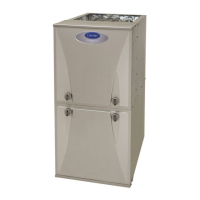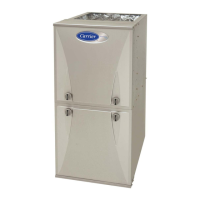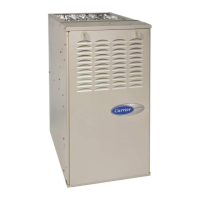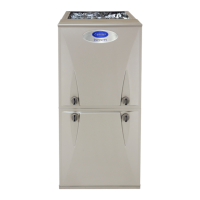PG92MSA: Installation, Start-up, Operating and Service and Maintenance Instructions
Manufacturer reserves the right to change, at any time, specifications and designs without notice and without obligations.
66
Simultaneously, the electronic air cleaner terminal EAC-1 is
energized and remains energized as long as the blower motor
BLWM is energized.
f. Blower-OFF Delay- When the thermostat is satisfied, the
R-to-W circuit is opened, de-energizing the gas valve GV,
stopping gas flow to the burners, and de-energizing the
humidifier terminal HUM. The inducer motor IDM will remain
energized for a 15-sec post-purge period. The blower motor
BLWM and air cleaner terminal EAC-1 will remain ON for 90,
120, 150, or 180 sec (depending on the blower-OFF delay
selection). The furnace control CPU is factory-set for a 120-sec
blower-OFF delay.
2. Cooling Mode
See Fig. 38 and Fig. 39 for thermostat connections
The thermostat “calls for cooling.” The thermostat closes the
R-to-Y circuits. The R-to-Y circuit starts the outdoor unit, and the
R-to-G and Y circuits start the furnace blower motor BLWM on
COOL speed. The electronic air cleaner terminal EAC-1 is
energized with 115 vac when the blower motor BLWM is operating.
When the thermostat is satisfied, the R-to-Y circuits are opened.
The outdoor unit will stop, and the furnace blower motor BLWM
will continue operating on the COOL speed for an additional 5, 30,
or 90 seconds (depending on the cooling blower-OFF delay
selection). The furnace CPU is factory set for a 90 second cooling
blower-OFF delay
3. Continuous Fan Mode
When the R-to-G circuit is closed by the thermostat, the blower
motor BLWM will operate at the continuous-blower speed selected.
Terminal EAC-1 is energized as long as the blower motor BLWM is
ON. During a call for heat, the blower BLWM will stop during
igniter warm-up (17 sec), ignition (7 sec), and blower-ON delay (25
sec), allowing the furnace heat exchangers to heat up more quickly,
then restarts at the end of the blower-ON delay period at HEAT
speed.
In heating, the furnace control CPU will hold the blower motor
BLWM at HEAT speed during the selected blower-OFF delay
period before reverting to continuous-blower speed.
When the thermostat “calls for high-cooling”, the blower motor
BLWM will continue to operate at COOL speed. When the
thermostat is satisfied, the blower motor BLWM will continue to
operate on COOL speed based on the cooling blower-OFF delay
setting before reverting back to continuous fan speed. When the
R-to-G circuit is opened, the blower motor BLWM will continue
operating for an additional 5 sec, if no other function requires
blower motor BLWM operation.
4. Heat pump
See Fig. 38 and Fig. 39 for thermostat connections. When installed
with a heat pump, the furnace control automatically changes the
timing sequence to avoid long blower off times during demand
defrost cycles. When the R-to-W-and-Y or R-to-W-and-Y-and-G
circuits are energized the furnace control CPU will continue to turn
on the blower motor BLWM at HEAT speed, and begin a heating
cycle. The blower motor BLWM will remain on until the end of the
prepurge period, then shut off for 24 sec then come back on at
HEAT speed. When the W input signal disappears, the furnace
control begins a normal inducer post-purge period and the blower
switches to COOL speed after a 3 sec delay. If the
R-to-W-and-Y-and-G signals disappear at the same time, the blower
motor BLWM will remain on for the selected blower- OFF delay
period. If the R-to-W-and-Y signals disappear, leaving the G signal,
the blower motor BLWM will continue running the blower motor at
CONTINUOUS FAN speed after the selected heating blower-OFF
delay period is completed.
Troubleshooting
Refer to the service label (see Fig. 61). The Troubleshooting Guide (see
Fig. 72) can be a useful tool in isolating furnace operation problems.
Beginning with the word “Start,” answer each question and follow the
appropriate arrow to the next item. The Guide will help to identify the
problem or failed component. After replacing any component, verify
correct operation sequence.

